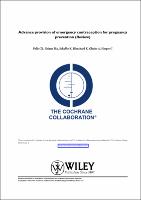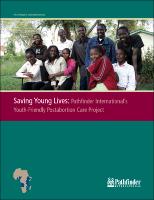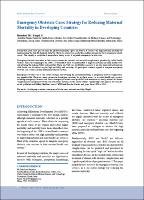Advance provision of emergency contraception for pregnancy prevention (Review)
Fecha
2010Autor
Polis, Chelsea
Grimes, David
Schaffer, Kate
Blanchard, Kelly
Glasier, Anna
Harper, Cynthia
Metadatos
Mostrar el registro completo del ítemResumen
Background
Emergency contraception can prevent pregnancy when taken after unprotected intercourse.Obtaining emergency contraception within
the recommended time frame is difficult for many women. Advance provision could circumvent some obstacles to timely use.
Objectives
To summarize randomized controlled trials evaluating advance provision of emergency contraception to explore effects on pregnancy
rates, sexually transmitted infections, and sexual and contraceptive behaviors.
Search strategy
In November 2009, we searched CENTRAL, EMBASE, POPLINE,MEDLINE via PubMed, and a specialized emergency contraception
article database. We also searched reference lists and contacted experts to identify additional published or unpublished trials.
Selection criteria
We included randomized controlled trials comparing advance provision and standard access (i.e., counseling whichmay ormay not have
included information about emergency contraception, or provision of emergency contraception on request at a clinic or pharmacy).
Data collection and analysis
Two reviewers independently abstracted data and assessed study quality. We entered and analyzed data using RevMan 5.0.23.
Main results
Eleven randomized controlled trials met our criteria for inclusion, representing 7695 patients in the United States, China, India and
Sweden. Advance provision did not decrease pregnancy rates (odds ratio (OR) 0.98, 95% confidence interval (CI) 0.76 to 1.25 in
studies for which we included twelve-month follow-up data; OR 0.48, 95% CI 0.18 to 1.29 in a study with seven-month follow-up data; OR 0.92, 95% CI 0.70 to 1.20 in studies for which we included six-month follow-up data; OR 0.49, 95% CI 0.09 to 2.74 in a
study with three-month follow-up data), despite reported increased use (single use: OR 2.47, 95% CI 1.80 to 3.40; multiple use: OR
4.13, 95% CI 1.77 to 9.63) and faster use (weighted mean difference (WMD) -12.98 hours, 95% CI -16.66 to -9.31 hours). Advance
provision did not lead to increased rates of sexually transmitted infections (OR 1.01, 95% CI 0.75 to 1.37), increased frequency of
unprotected intercourse, or changes in contraceptive methods.Women who received emergency contraception in advance were equally
likely to use condoms as other women.
Authors’ conclusions
Advance provision of emergency contraception did not reduce pregnancy rates when compared to conventional provision. Results from
primary analyses suggest that advance provision does not negatively impact sexual and reproductive health behaviors and outcomes.
Women should have easy access to emergency contraception, because it can decrease the chance of pregnancy.However, the interventions
tested thus far have not reduced overall pregnancy rates in the populations studied.
Colecciones
Ítems relacionados
Mostrando ítems relacionados por Título, autor o materia.
-
Saving Young Lives: Pathfinder International’s Youth-Friendly Postabortion Care Project
Pathfinder International (Pathfinder International, 2008-10)As many as 2.5 million adolescent women seek abortion each year, and nearly 70,000 women die from complications related to unsafe abortion, of which almost half are women under the age of 25. A further 5 million women ... -
Emergency Obstetric Care: Strategy for Reducing Maternal Mortality in Developing Countries
Bhandari, TR; Dangal, G (2014)Twenty-five years have passed since the global community agreed in Nairobi to address the high maternal mortality by implementing the Safe Motherhood Initiative. However, every year nearly three million women die due to ... -
Signal functions for measuring the ability of health facilities to provide abortion services: an illustrative analysis using a health facility census in Zambia
Campbell, Oona; Aquino, Estela; Vwalika, Bellington; Gabrysch, Sabine (BMC Pregnancy and childbirth, 2016)Background Annually, around 44 million abortions are induced worldwide. Safe termination of pregnancy (TOP) services can reduce maternal mortality, but induced abortion is illegal or severely restricted in many countries. ...



